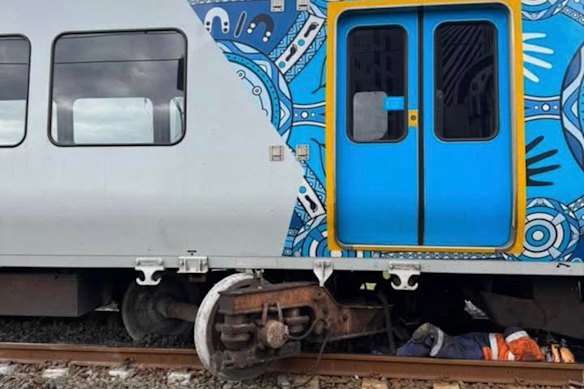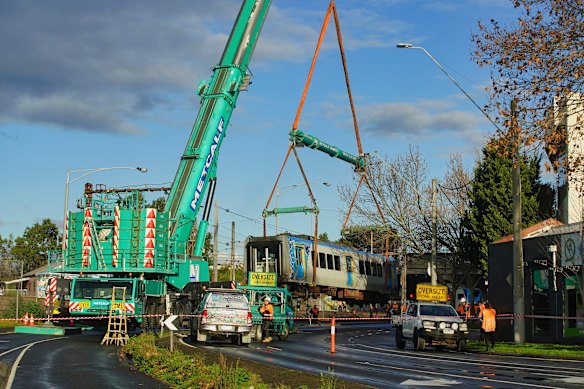‘Something underneath failed badly’: Safety investigators to probe train derailment
By Patrick Hatch, Alexander Darling and Hannah Hammoud
Safety investigators will probe how a Metro Trains carriage swung far enough off the tracks to collide with a pillar during a derailment that will paralyse two of Melbourne’s key rail lines for more than a week.
Metro Trains has confirmed services on the Hurstbridge and Mernda lines will remain suspended until at least Monday while it repairs damage to infrastructure that happened in the incident at Clifton Hill on Sunday.

Photos show the bogie twisted out from underneath the carriage. Credit: Patrick Hatch
A crane was used at the site on Tuesday afternoon to remove the derailed carriage, allowing Metro Trains to assess the extent of the damage. The Office of the National Rail Safety Regulator is investigating the incident.
Metro Trains CEO Raymond O’Flaherty said it was “too early to pinpoint what’s caused this”.
The partially derailed train became stuck on the tracks at a bottleneck on the Melbourne network on Sunday evening.
The city-bound X’Trapolis 100 train had 55 passengers on board and was travelling on the Mernda line towards Clifton Hill station about 10.30pm on Sunday when the fifth carriage came partly off the rails.
O’Flaherty said one bogie – a series of four wheels – on the train’s fifth carriage came off the rails.
The carriage hit a trackside stanchion (a rail pillar), causing significant damage and the train’s pantograph – the antenna-like structure – became entangled in overhead wires.
Rail Safety Consulting director Phillip Barker, who has probed scores of derailments over his 45-year career, said it was difficult to say for certain what caused the derailment until the full investigation was completed.
However, Barker reviewed photographs from the scene and said it was unusual for a bogie to be so significantly damaged in a derailment. The photos show it twisted out from underneath the carriage.

The train carriage is removed from the tracks on Tuesday afternoon after derailing at Clifton Hill on Sunday evening.Credit: Luis Ascui
“It’s obviously hit something, or it’s travelled some distance [after derailing],” he said.
Barker said derailed trains usually remained in reasonably close alignment with the tracks, but in this case, the carriage swung out far enough to hit a stanchion, which are at least a metre from the tracks. “So there’s something else going on that drives it sideways,” he said.
“It looks like a textbook derailment but the consequences – how the bogie is so skew-whiff and how the coach has collided with a stanchion – that’s unusual. It’s not often you see that sort of thing.”
One Metro train driver, who spoke on condition of anonymity to protect their employment, said the damaged bogie was extremely unusual and concerning.
“It shouldn’t be twisted under the body – the wheels shouldn’t come out and turn almost 180 degrees. It’s indicating something underneath had failed badly,” the driver said.
The derailment occurred on a curved section of track between Rushall and Clifton Hill stations where trains have to slow down to 40km/h.
“So to see the damage at that low speed, it’s way beyond what you expect. If this happened at 80km/h then the damage would have been enormous and the train would have toppled over,” the driver said.
O’Flaherty defended Metro’s safety record and assured passengers that the network was “very safe”.
“This is a significant incident and incidents like this … happen very, very rarely,” O’Flaherty said.
He said there was “a significant amount of work to recover and reinstate all the assets back into a safe working condition”.
“We’re confident that we’ll resume passenger services on Monday morning – next Monday. There’s a lot of work to be done over the next three to four days, and then final testing and commissioning on Sunday,” he said.
“We’re working around the clock as fast as we can. But it’s too early to pinpoint what’s caused this.”
Public Transport Users Association spokesperson Daniel Bowen said the derailment and closure of the two lines for more than a week was the most significant infrastructure failure since private operator Metro Trains took over the network in 2009.
“Ultimately, they do need to understand what happened and what caused it and what needs to be done to,” Bowen said. “Was there an infrastructure fault, a fault on the train or has something else happened.”
All passengers were evacuated safely from the derailed train on Sunday evening.
The Department of Transport and Planning said Hurstbridge Line passengers will need to use buses between Eltham and Parliament stations, while Mernda Line passengers will use buses between Reservoir and Parliament until the track is back online.
Buses had already been operating on the Hurstbridge Line between Heidelberg and Eltham due to planned works, which will continue until Thursday, July 24.
O’Flaherty said passengers would be entitled to compensation if the line suspensions pushed Metro below its monthly reliability targets, which are calculated on a network-wide basis.
Passengers can claim the value of a daily ticket in myki credit through the compensation process, which is only available if they hold a pre-pay monthly or yearly pass.
“Obviously, we know this is severely impacting passengers, and we’re very, very sorry, deeply apologetic for that,” O’Flaherty said.
Rail, Tram and Bus Union Victorian branch secretary Vik Sharma said the incident required a thorough investigation.
“While unforeseen issues occur, we must recognise the important work done by the skilled and qualified driver, operations and maintenance teams in responding to this critical incident,” he said.
The Office of the National Rail Safety Regulator (ONRSR) has engineering and rolling stock specialists leading its investigation into the derailment, a spokesperson for the safety watchdog said.
ONRSR investigates rail safety incidents to identify any immediate safety concerns, and potential operator safety breaches.
Start the day with a summary of the day’s most important and interesting stories, analysis and insights. Sign up for our Morning Edition newsletter.